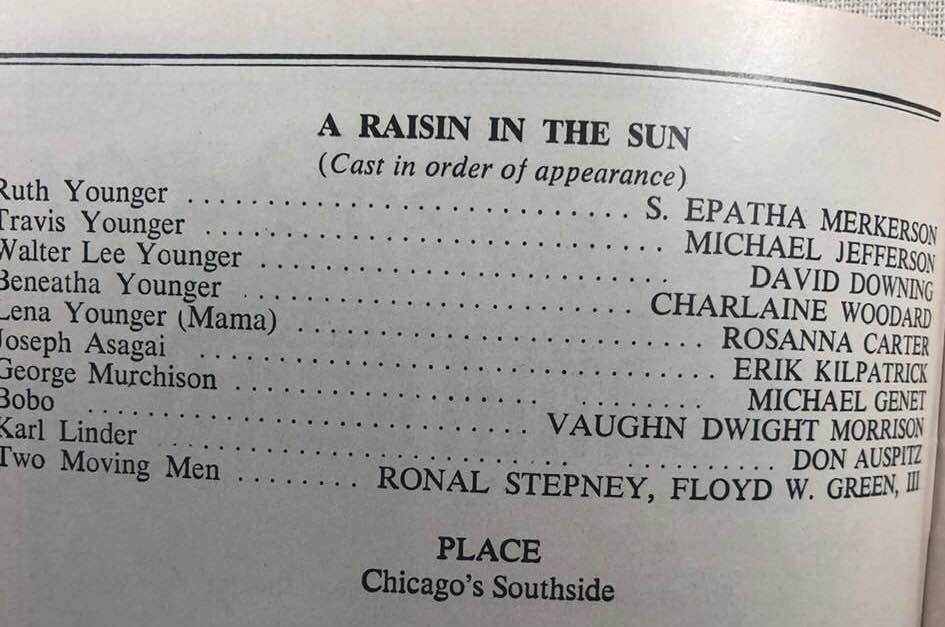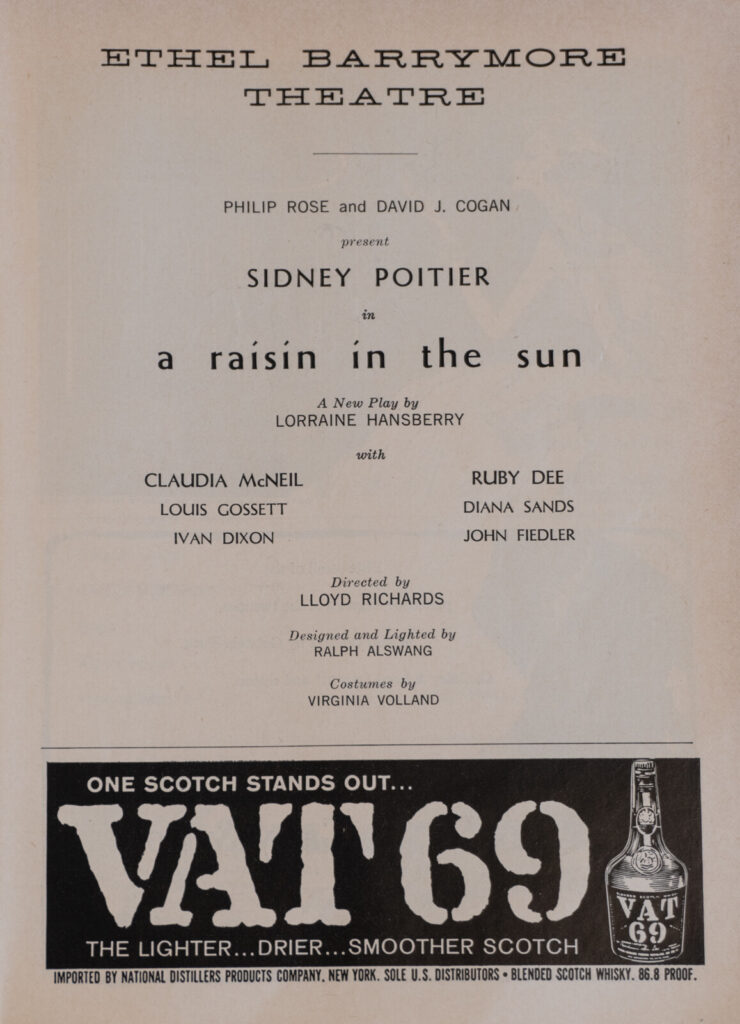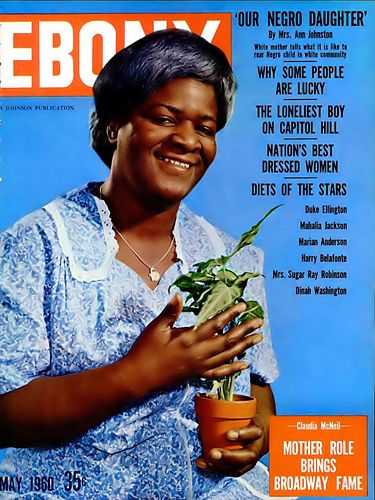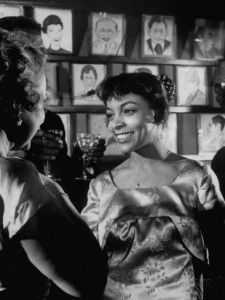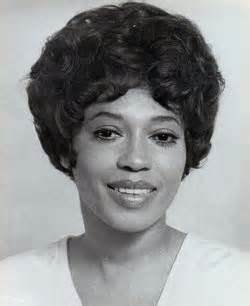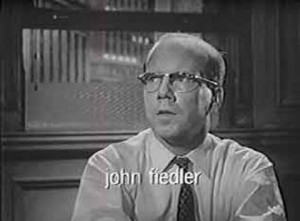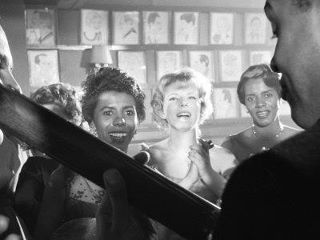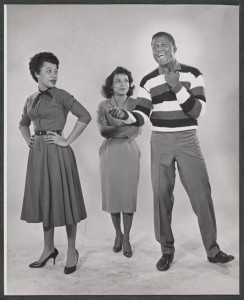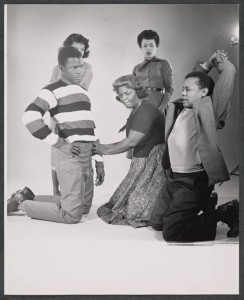Lorraine Vivian Hansberry

The New York Drama Critics’ Circle named A Raisin in the Sun the best play of 1959.
Lloyd Richards (Director) and Lorraine Hansberry (Playwright)
Richards and playwright Lorraine Hansberry in the Ethel Barrymoore Theatre
In 1960, A Raisin in the Sun was nominated for 4 Tony Awards, which recognize achievement in live Broadway theatre.
Sidney Poitier is most known for being the first Black person to win an Academy Award
for Best Actor for his role in Lillies in a Field in 1963.

Sidney Poitier in A Raisin in the Sun, New York, 1959 (Gordon Parks – Flickr)
Ruby Dee is a critically acclaimed African American actor and was a civil rights activist during the Civil Rights Movement.
“As an actress, playwright, activist, and poet, Ruby Dee is one of the most accomplished women of our time. The Raisin in the Sunstar has won an Emmy, a Grammy, a SAG award and was a recipient of the 2004 Kennedy Center Honors (along with her late husband, Ossie Davis)”
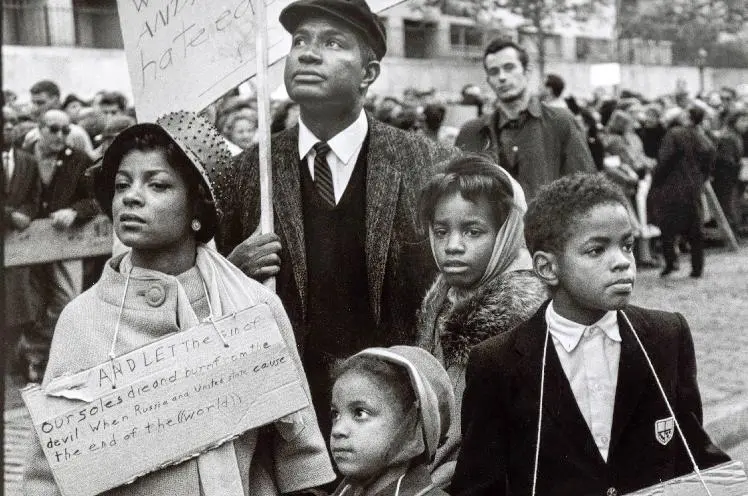
Lorraine Hansberry Documentary Project co-director /producer Tracy Heather Strain interviewed Ruby Dee in February 2009.
The nominations were as follows:
A Raisin in the Sun for Best Play
Synopsis
“Lorraine Hansberry’s landmark drama was one of the first on Broadway to examine African-American life on the cusp of the civil rights era. Walter Younger and his mother, Lena, both yearn to move their family out of Chicago’s Southside ghetto. When Lena’s late husband’s insurance check arrives, Lena hopes to use it to buy a house in a white neighborhood — while Walter hopes to invest it in the liquor business.”
Sidney Poitier for Best Actor in a Play

“He acted in the first production of A Raisin in the Sun on Broadway in 1959, and later starred in the film version released in 1961.”
http://en.wikipedia.org/wiki/Sidney_Poitier
Claudia McNeil for Best Actress in a Play
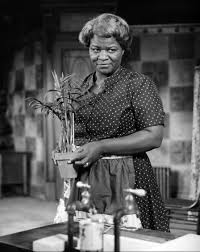
“Claudia McNeil (August 13, 1917 – November 25, 1993) was an American actress known for premiering the role of matriarch Lena Younger in both the stage and screen productions of A Raisin in the Sun. She later appeared in a 1981 production of the musical version of the play, Raisin presented by Equity Library Theater. She was twice nominated for a Tony Award, first for her onstage performance in A Raisin in the Sun (1959), and again for the play Tiger Tiger Burning Bright in 1962. She was also nominated for a Golden Globe Award for the screen version of A Raisin in the Sunin 1961.” – (From Wikipedia, the free encyclopedia)
http://en.wikipedia.org/wiki/Claudia_McNeil
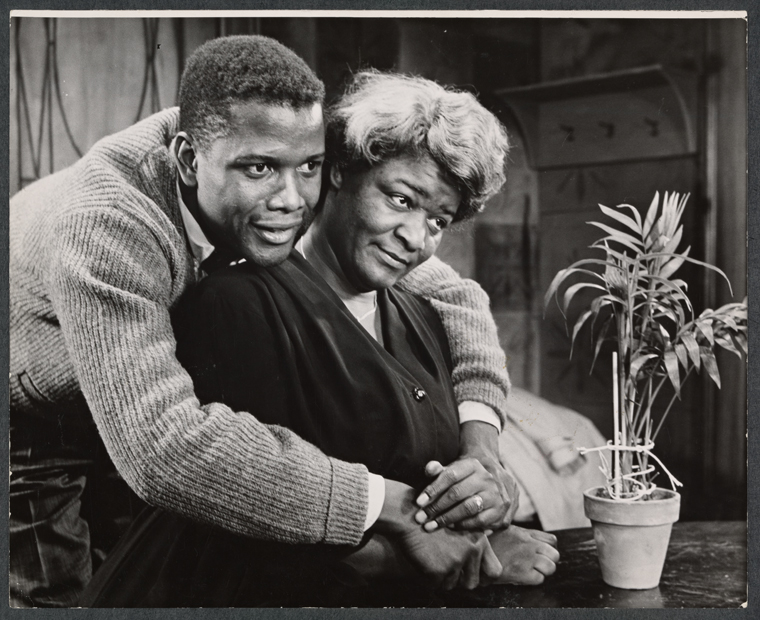
Sidney Poitier and Claudia McNeil [NYPL]
Lloyd Richards

Starting tomorrow the same 47th Street Broadway block that contains the Lena Horne Theater and the Barrymore Theater where the Broadway debut occurred of “A Raisin In The Sun” will be forever known as “Lloyd Richards Way”
June 29th, 2024
~*~
Lloyd Richards for Best Direction of a Play
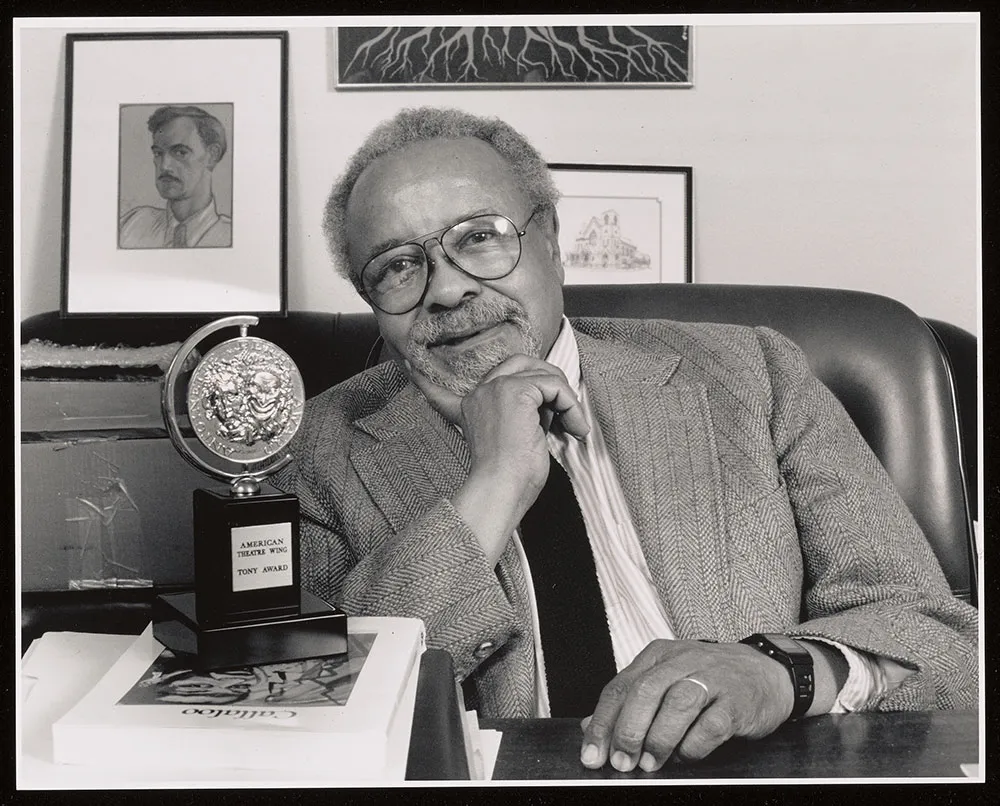
Lloyd George Richards was a Canadian-American theatre director, actor, and dean of the Yale School of Drama from 1979 to 1991, and Yale University professor emeritus.
Born in Toronto, Canada – but raised in Detroit Michigan – by Jamaican parents, Lloyd Richards was one of the most important figures in American theater during the latter half of the 20th century. He was the first African American to direct a Broadway play, a champion of more than 3 generations of young actors, directors and playwrights including discovering playwright August Wilson. Richards helped develop the Pulitzer Prize-winning writer’s voice through collaboration on Wilson’s significant early works for the stage, and directed their acclaimed Broadway runs. Wilson’s stories chronicling the struggle for dignity and respect by African Americans giving voice to the men and women both Richards and Wilson knew all too well from their humble pasts.
When he was four years of age Richards moved with his family across the Canadian border to Detroit. There, his carpenter-father found work in one of the automobile factories. Richards was only nine years old when his father died, leaving his mother to raise five children alone in the depths of the Depression. The rest of his youth was marked by poverty and hardship: His mother worked as a domestic servant to support her five children. Life became still more difficult for the Richards family when Mrs. Richards became blind due to the negligence of her physician two years later. Lloyd, only 13, went to work shining shoes and sweeping floors in a barbershop to help put food on the table. Later on, while a student at Wayne University in Detroit, Richards would earn money as an elevator operator, taking his fellow classmates up and down to their classes on the four floors of the Old Main Building.
The Richards family believed in the importance of education, and despite their difficult circumstances, he and his siblings were encouraged to study hard and go to college. He became interested in theater, initially, as a teen, and majored in it at Wayne University. His studies were interrupted by World War II. He volunteered served in the U.S. Army Air Corps’ segregated division of fighter pilots known as the Tuskegee Airmen. He was in training when the war ended in 1945.
Back in Detroit, he sought stage roles while working as a disc jockey, and helped to start a theater company. Finding only limited opportunities to act, Richards moved to New York City in 1947. Roles for African American actors were hard to come by, but Richards did find a few roles on Broadway. Specifically, he found early employment in the dramas “Freight” and “The Egghead.” He did find work on radio throughout the 1950s but it was more “clandestine.” Although Richards had a well-trained voice that adhered to a common midwestern standard of speech, may radio productions took at risk in hiring him. If it were discovered that his radio work was done by a Black actor, the shows would be pulled from the air throughout the South.

L to R: Sidney Pointier, Paul Mann, & Richards
In between Off-Broadway roles, Richards waited tables and found steady work as an acting teacher at the Paul Mann Studios. Through these classes he met another struggling actor, Sidney Poitier. Sharing Jamaican ancestry, Richards and Poitier developed a lifelong friendship. Eventually, Poitier introduced him to playwright Lorraine Hansberry, and that led to Richards’ first-time foray into directing. The play was “A Raisin in the Sun,” the landmark original production which opened at Broadway’s Ethel Barrymore Theater on March 11, 1959. The show was nominated for several Tony Awards, including Best Director, and gave Richards the distinction of being the first African American ever to direct a play on Broadway.
Despite the success of “A Raisin in the Sun,” Richards had a difficult time following it up with another hit. He directed a stage adaptation of Richard Wright’s novel “The Long Dream” as well as “The Moon Besieged.” Both shows closed during their opening week of performances. He then ventured into works that were not exclusively focused on African-American themes, such as a musical adaptation of “The Yearling” in 1965, only to see it close the night after it opened. He was hired to direct a staged adaptation of James Baldwin’s The Amen Corner but ran into issues with producers and was fired from the show.
L to R: Richards and playwright Lorraine Hansberry in the Ethel Barrymoore Theatre
Once again Lloyd Richards leaned on his background as a acting couch. He became the head of the actor training program at New York University’s School of the Arts, in 1966. In 1968 he took a concurrent post as director of the National Playwrights Conference at the O’Neill Theater Center in Waterford, Connecticut. An annual summer workshop, the conference hosts a group of playwrights – some well-known while others are up-and-coming – to nurture their new work to a final draft with the help of a resident cast, director and dramaturge. Under his leadership the O’Neill developed new works by John Guare, Arthur Kopit, Wendy Wasserstein, Christopher Durang, and David Henry Hwang. African or African American playwrights who had plays developed include Derek Wolcott, Wole Soyinka, Charles OyamO Gordon, Richard Wesley, Philip Hayes Dean, and most famously, August Wilson.
He was Professor of Theater and Cinema at Hunter College in New York City before he was tapped, in 1979, to become Dean of the prestigious Yale University School of Drama. At the same time he became Artistic Director of the highly influential Yale Repertory Theatre.
Throughout his career, Lloyd Richards sought to discover and develop new plays and playwrights, as a member of the Playwrights’ selection committee of the Rockefeller Foundation and of the New American Plays program of the Ford Foundation, and as Artistic Director of the National Playwrights Conference at the Eugene O’Neill Memorial Theatre Center from 1968 to 1999. Richards’s long search for a major new American playwright bore fruit with the 1984 production of “Ma Rainey’s Black Bottom” by August Wilson. Throughout the 1980s and into the ’90s, Richards directed the Yale Rep and New York productions of the successive installments of August Wilson’s multi-part chronicle of African American life. The plays in this cycle include “Fences,” “Joe Turner’s Come and Gone,” “The Piano Lesson,” “Two Trains Running” and “Seven Guitars.” They ended their professional relationship in 1996 following the Broadway run of “Seven Guitars.”
Richards’s television credits included segments of “Roots: The Next Generation,” “Bill Moyers’ Journal” and “Robeson,” a presentation on the life of the African American actor and activist Paul Robeson, who was an early inspiration for the young Lloyd Richards. Richards also dealt with Robeson’s life and legacy in the 1977 theatrical production “Paul Robeson.” Richards was the recipient of the Pioneer Award of AUDELCO, the Frederick Douglass Award and, in 1993, was awarded the National Medal of the Arts. He also served as President of the Society of Stage Directors and Choreographers.
Richards retired from Yale in 1991, and from the O’Neill Center in 1999. In his later years he suffered from cardiovascular disease, and died of heart failure on June 29, 2006, at Mount Sinai Hospital in New York City. It was his 87th birthday. Survivors include his wife, Barbara Davenport Richards, a onetime Broadway dancer he wed in 1957, and their sons, Scott and Thomas. – https://blacktheatrematters.org/2021/02/10/black-history-month-legend-lloyd-richards/
“If you aspire at all, you’re taking a risk. If you aspire as a young Black person to something where there is not a beaten path, you’re taking a risk. So risk is nothing new in your life. But then, some risks cost more than others. I never decided to take risks with my life, I just had no choice.” – Lloyd Richards
“Among Richards’ accomplishments are staging the original production of Lorraine Hansberry‘s A Raisin in the Sun, debuting on Broadway to standing ovations on 11 March 1959, and in 1984 he introduced August Wilson to Broadway in Ma Rainey’s Black Bottom. As head of the National Playwrights Conference at the Eugene O’Neill Theater Center, he helped develop the careers of Wendy Wasserstein, Christopher Durang, Lee Blessing, and David Henry Hwang. Richards died of heart failure on his eighty-seventh birthday in New York City. Mr. Richards also taught Moscow Art Theatre acting technique under Paul Mann at the Actor’s Workshop in New York alongside Morris Carnovsky.”
The 1961 film adaptation also received several awards: The National Board of Review recognized Ruby Dee with the Best Supporting Actress Award for her role in the film version of A Raisin in the Sun.
*
Robert Hooks
MORE BLACK THEATRE HISTORY!..More Black Theatre Pioneers
While studying drama and theatre at the Bessie V. Hicks School of Drama in Philadelphia, (circa 1958,) I first met Lloyd Richards when he came to Philly and was directing the only all-Black professional play I had ever seen “A Raisin in the Sun“, which was on its way to open on Broadway. I was there that opening night at the Walnut Street Theatre to witness this amazing and brilliant Lorraine Hansberry play, the first play ever presented in America by a Black woman playwright. It was a mind-blowing experience for this young wannabee theatre artist and was the sole reason I simply had to move to New York to pursue my acting career. It’s a long story (which of course is covered in my memoir) but I’ll shorten the amazing tale for this MBTH series.
When I got to New York three months later, my very first professional acting assignment was replacing the late great artist Louis Gossett Jr., in that same play that prompted me to move to Gotham.
A Raisin in the Sun. Louis was leaving the show to go to Hollywood to do the Raisin movie. Lloyd Richards cast me in Raisin, and from that point on we became great friends and theatre colleagues.

Robert Hooks and Diana Sands in “A Raisin in the Sun.”
It was a great and life-changing experience for me. I saw the play in previews in Philadelphia, the first Black play I had ever seen in my life, the experience prompted me, a few months later, to just pack up and move to New York, because I knew I wanted it. When that curtain went up on A Raisin in the Sun and the lights went up, I thought I was in my own living room on Horton Street. That’s what it looked like, and that kind of got to me. I’m sitting there at the end of the play crying like a baby because of what I felt watching people who looked like me on that stage telling their own story; it just took me aback emotionally. The applause was so exciting and amazing; I was the first one on my feet, yelling “Bravo” and clapping—so much so, I broke the band on my wristwatch and the whole thing fell on the floor and I couldn’t find it, I was too busy clapping and yelling. That defined it for me.
After I saw Raisin in Philadelphia at the Walnut Street Theatre, I just had to go backstage to meet this amazing cast. I couldn’t get into Sidney Poitier’s dressing room because it was too crowded; I couldn’t get into Claudia McNeil’s dressing room because it was also too crowded. And then I looked down at the end of the hall to the men’s dressing room, so I go down there to meet some of the guys. I walk in, there’s Ivan Dixon, Lou Gossett, Douglas Turner Ward, Ed Hall there’s Lonne Elder III. And there’s young Glynn Turman—at the time he was just a youngster playing Travis in the play. Now he’s doing grandfather roles, for crying out loud! That’s how long ago it was. Anyway, I start talking to these guys, and I tell them I’m a local actor, and ask them what they thought I should do. I said, “There are no roles for me here in Philly.” Lonne Elder chimes in, “Well, come on up to New York and join the unemployment line like everybody else.” We all got a big laugh! They were so nice to me; I couldn’t believe the warm welcome they gave me.
A few months later I had moved up to New York to pursue an acting career. By then, Raisin was a big smash hit on Broadway. I go backstage, and I started hanging out with these great guys I’d already met in Philadelphia. One day I’m walking down 47th Street and I run into Ed Hall—actually, he was an understudy for Lou Gossett and Ivan Dixon. And he says, surprisingly, “Bobby, you should get over to Phil Rose’s office now, because Lou Gossett is leaving for Hollywood and they’re going to replace him.” I thought wow, this is my opportunity, right? But I’m also thinking, Ed Hall was the understudy for Louis and Ivan—why isn’t he replacing Louis in the role? I never learned the answer to that. But I ran up Broadway to 57th Street, 10 blocks up Broadway to get to Phil Rose’s office to audition, to be Lou Gossett’s replacement in the biggest Black play on Broadway. I run into the building. I go up to the seventh floor, and I don’t know which room it is, but the elevator door opens, and this little guy appears; I almost ran over him. I asked, “Could you tell me where Phil Rose’s office is?” He says, “It is right over there.” I rush in and the little man comes in right behind me. Yes, it was Phil Rose that I almost took out coming out of the elevator.
Phil Rose asked his assistant to bring a script in so he could audition me. He asked me how I knew about the role, since they hadn’t even officially announced it. I said, “Ed Hall told me about it. And Mr. Rose, I really don’t need a script. I know the role; I know all the lines; I know all the lines of everybody in the show.” He said, “Well, do you mind if I have a script? I don’t know the lines.” I read with him, he liked my reading, and he called the theatre immediately. He told me to go to the theatre because director Lloyd Richards was there. I’m blown away. I’m going to go read for Lloyd Richards, to replace Lou Gossett! I get to the theatre. I walk out on the stage. I’m standing there in the street just outside the stage door and Lloyd Richards walks out, and then from the wings walks the actress Billie Allen, who was Diana Sands’s understudy in the play. She and I get set to read the two scenes. After the first scene, Richards liked what I did and gave me a couple of notes for the second scene. I read the second scene as well. I’m feeling great, I’m feeling fantastic. And he dismissed Billie and he says, “We’re not going to audition any other actor for this role. It’s yours. Have your agent call Phil Rose’s office.” Well, guess what! I didn’t have an agent. I didn’t tell him that, but long story short, Diana Sands was so happy for me, that Diana called her agent and he represented me and made my deal for A Raisin in the Sun.
– https://www.americantheatre.org/2022/08/04/robert-hooks-its-always-about-the-ensemble/
When Douglas, Jerry Krone, and I created the Negro Ensemble Company in 1967, Lloyd loved our concept and mission and insisted on being involved, and immediately joined NEC’s Training Program Faculty where he taught our young students, as well as NEC’s professional ensemble artists while they prepared for their new season. He fell in love with the youngsters and the seasoned artists and his acting workshops were always full to standing room. Eventually, NYU and Yale came a calling, and Lloyd went on to head those Drama Schools (where he discovered the great playwright, August Wilson,) but he graced the new NEC institution with his teaching brilliance FIRST! …Lloyd Richards, is a great and truly original Black theatre pioneer.
*
Ruby Dee

Ruby Dee in the stage production A Raisin in the Sun [NYPL]
http://en.wikipedia.org/wiki/Ruby_Dee
Sidney Poitier and Claudia McNeil were nominated for Golden Globe Awards for their roles in the film.
~*****~
Diana Sands

[NYPL]
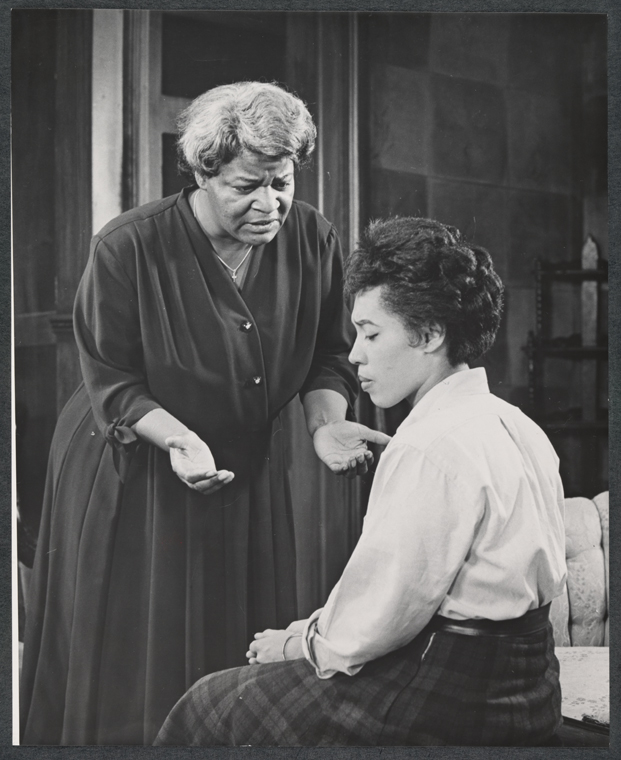
http://en.wikipedia.org/wiki/Diana_Sands
.John Fiedler
John Fiedler has played character roles in celebrated dramas on Broadway and in Hollywood but gained lasting fame among young audiences as the voice of Piglet in Walt Disney’s Winnie-the-Pooh films.
Mr. Fiedler had appeared in the Broadway and film productions of “A Raisin in the Sun” and had played a juror on film in the drama “Twelve Angry Men.”
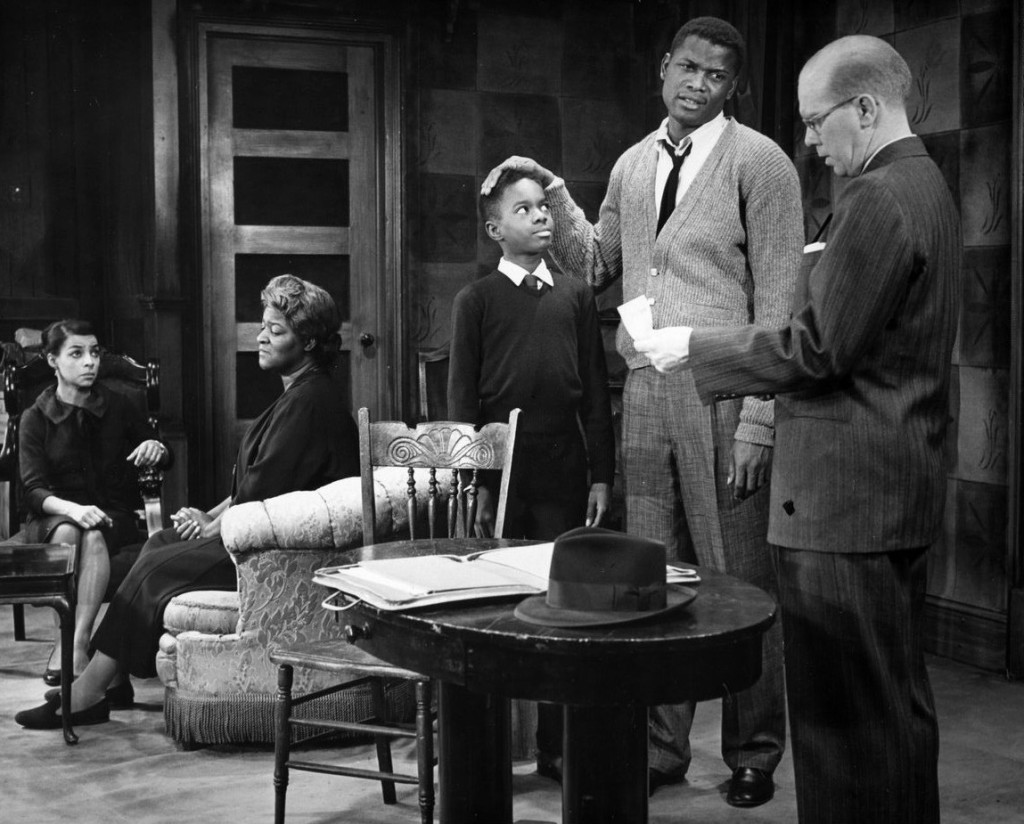
John Fiedler in the stage production A Raisin in the Sun[NYPL]
Louis Gossett Jr.
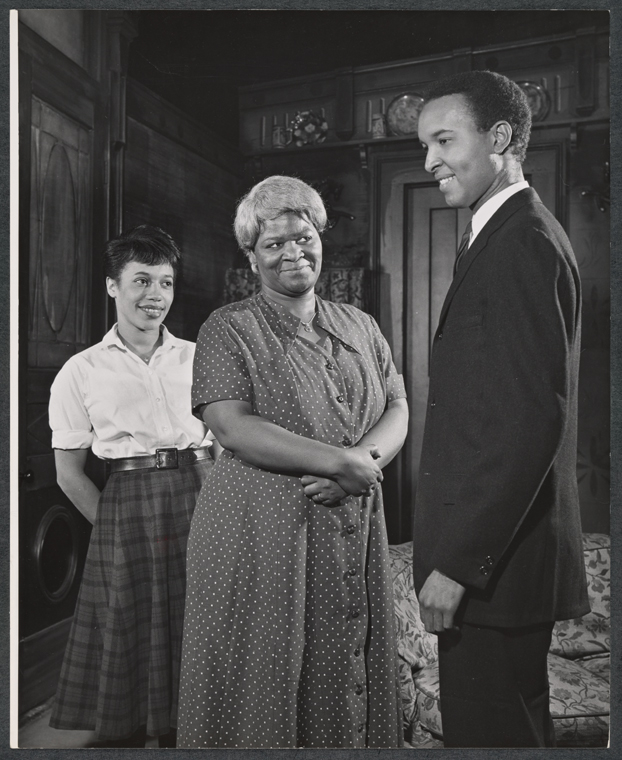
Diana Sands, Claudia McNeil, and Louis Gossett in the stage production A Raisin in the Sun [NYPL]
Glynn Turman
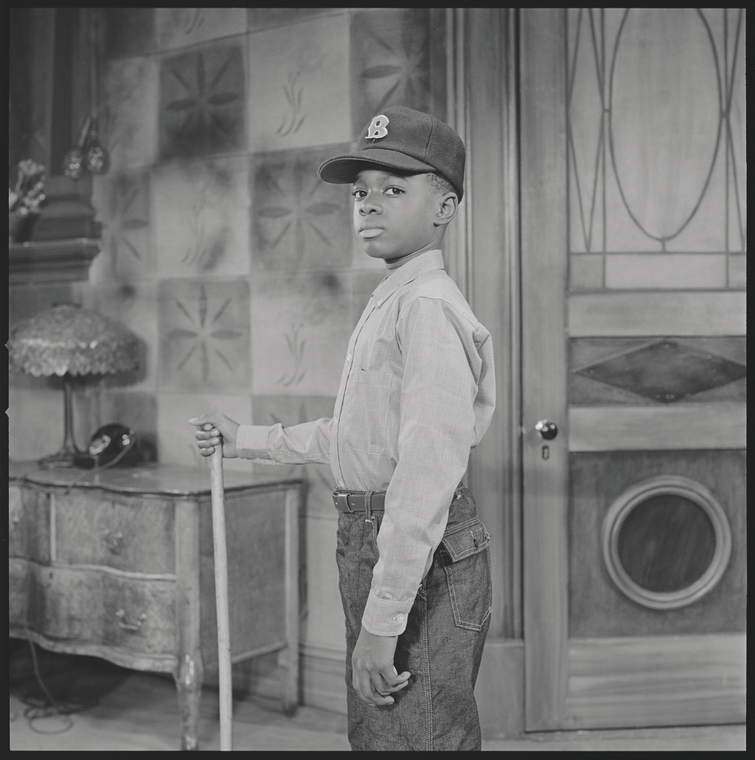
Glynn Turman [NYPL]
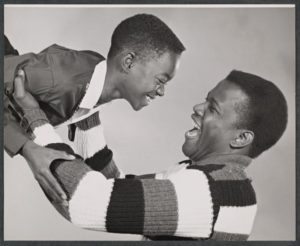

Ruby Dee and Glynn Turman

Sidney Poitier and Glynn Turman [NYPL]
~*****~
♫•*♪.¸♪♫•*OPENING NIGHT!♪♫•.*•♪
A Raisin in the Sunopening night at Sardi’s
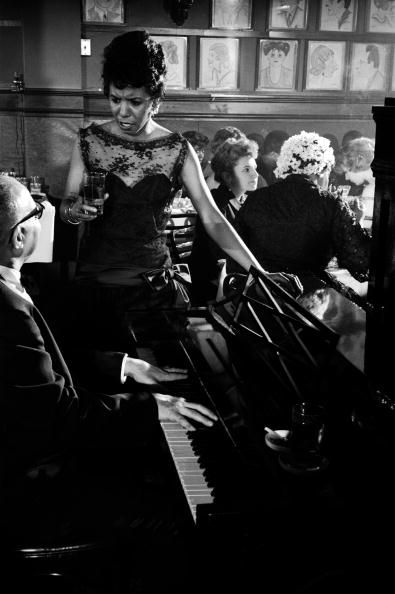
Lorraine Hansberry is captured by Gordon Parks chatting with the pianist at a party in honor of her play A Raisin in the Sun at the now legendary Manhattan restaurant, Sardi’s in March 1959. Photo: Gordon Parks/Time Life Pictures/Getty Images
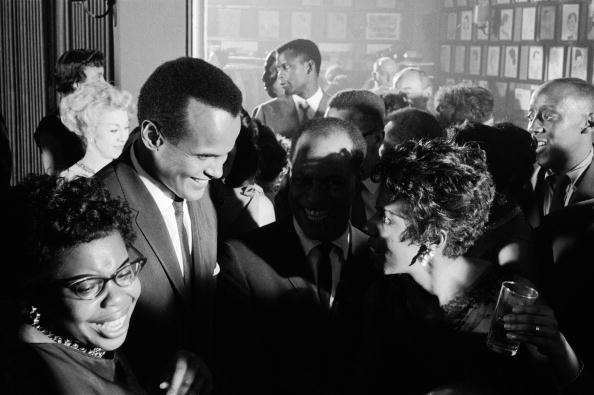
Gordon Parks captures Lorraine Hansberry chatting with Harry Belafonte (Sidney Poitier is in the rear and actor Godfrey Cambridge) at a party in honor of Ms. Hansberry’s smash Broadway play, ‘A Raisin in the Sun,’ at Sardi’s in New York City in March 1959. Photo: Gordon Parks/Time Life Pictures/Getty Images.
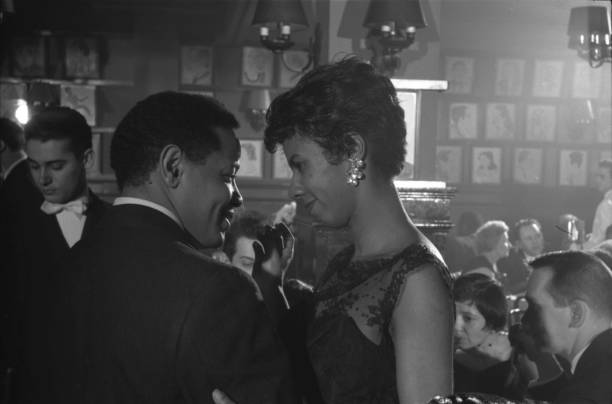
American playwright Lorraine Hansberry (1930 – 1965) dances with Lloyd G. Richards during a party, in honor of her Broadway play ‘A Raisin in the Sun,’ at Sardi’s restaurant, New York, New York, March 1959. (Photo by Gordon Parks/The Life Picture Collection/Getty Images)
Reviews
But she has not tipped her play to prove one thing or another. The play is honest. She has told the inner as well as the outer truth about a Negro family in the south-side of Chicago at the present time. Since the performance is also honest and since Sidney Poitier is a candid actor, A Raisin in the Sun has vigor as well as veracity and is likely to destroy the complacency of anyone who sees it.
What the situations do not matter at the moment. For A Raisin in the Sun is a play about human beings who want, on the one hand, to preserve their family pride and, on the other hand, to break out of the poverty that seems to be their fate. Not having any axe to grind, Miss Hansberry has a wide range of topics to write about some of them hilarious, some of them painful in the extreme.
You might, in fact, regard A Raisin in the Sun as a Negro The Cherry Orchard. Although the social scale of the characters is different, the knowledge of how a character is controlled by the environment is much the same, and the alternation of humor and pathos is similar.
http://theater.nytimes.com/mem/theater/treview.html?id=1077011428967&html_title=&tols_title=&byline=&fid=NONE
A Raisin in the Sun
The Philadelphia Guild
David Downing – Rosaana Carter – S Epatha Merkinson – Charlayne Woodard
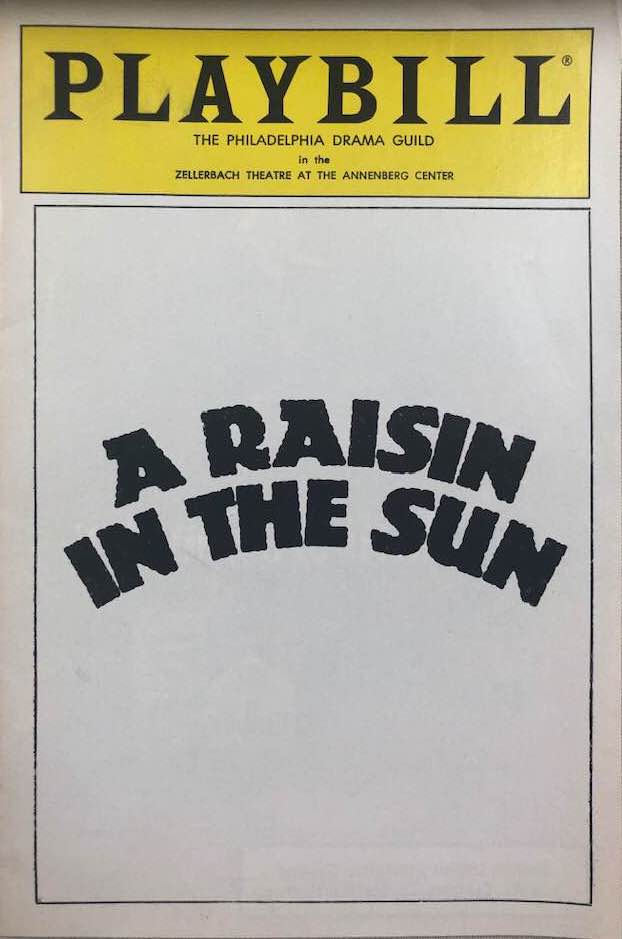
A Raisin in the Sun
The Philadelphia Guild
